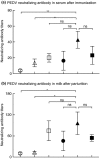A heterologous 'prime-boost' anti-PEDV immunization for pregnant sows protects neonatal piglets through lactogenic immunity against PEDV
- PMID: 31278766
- PMCID: PMC7165963
- DOI: 10.1111/lam.13197
A heterologous 'prime-boost' anti-PEDV immunization for pregnant sows protects neonatal piglets through lactogenic immunity against PEDV
Abstract
Porcine epidemic diarrhoea virus (PEDV) causes severe diarrhoea in neonatal suckling piglets with a high mortality. Maternal vaccines that can induce lactogenic immunity to protect suckling piglets via colostrums and milk are pivotal for the prevention and control of PEDV infection in neonatal suckling piglets. In this study, a group of pregnant sows were first orally immunized with coated PEDV-loaded microspheres and boosted with killed PEDV vaccines (heterologous prime-boost). It has been detected that the levels of PEDV-specific antibodies (IgG and IgA) in their sera and milks were higher than other negative groups (P < 0·001 or P < 0·05). Furthermore, it has been proved by the neutralization assay that the induced antibodies could significantly inhibit virus infection as compared to other negative groups (P < 0·01 or P < 0·05). Importantly, after PEDV challenge, more than 90% of the suckling piglets delivered by the sows in the heterologous prime-boost group were completely protected. Overall, the results show that 'heterologous prime-boost' form is an efficient and effective way to provide protection for suckling piglets against PEDV through lactogenic immunity. SIGNIFICANCE AND IMPACT OF THE STUDY: As a widespread swine pathogen, PEDV affects the swine industry enormously. It causes enteritis in swine of all ages and is often fatal in neonatal piglets. Our data show that pregnant sows were immunized with 'coated PEDV-loaded microspheres + killed PEDV vaccines' (heterologous prime-boost immunization) could protect more than 90% suckling piglets delivered by the sows against the virus. These findings provide a new model of developing safe and effective immunizations for newborn animals against established and emerging enteric infections.
Keywords: coated PEDV-loaded microspheres; heterologous prime and boost; pig; porcine epidemic diarrhoea virus (PEDV); vaccine.
© 2019 The Society for Applied Microbiology.
Conflict of interest statement
The authors declare that they have no conflict interest.
Figures



References
-
- Boyer, J.D. , Robinson, T.M. , Maciag, P.C. , Peng, X. , Johnson, R.S. , Pavlakis, G. , Lewis, M.G. , Shen, A. et al (2005) DNA prime Listeria boost induces a cellular immune response to SIV antigens in the rhesus macaque model that is capable of limited suppression of SIV239 viral replication. Virology 333, 88–101. - PubMed
-
- Chattha, K.S. , Roth, J.A. and Saif, L.J. (2015) Strategies for design and application of enteric viral vaccines. Annu Rev Anim Biosci 3, 375–395. - PubMed
MeSH terms
Substances
Grants and funding
LinkOut - more resources
Full Text Sources
Research Materials
Miscellaneous

